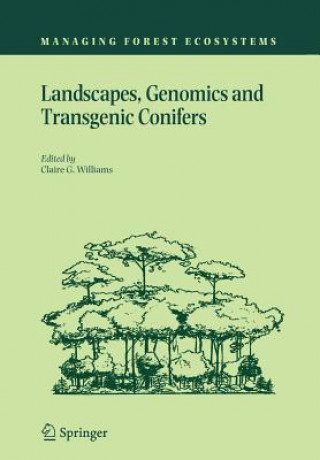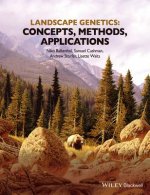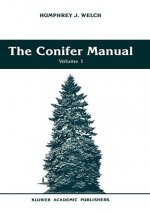
Livrare
Consilier de cumpărături





Nu se pretează? Nu contează! La noi puteți returna bunurile în 30 de zile
 Voucher cadou
orice valoare
Voucher cadou
orice valoare
Cu un voucher cadou nu veți da greș. În schimbul voucherului, destinatarul își poate alege orice din oferta noastră.
Landscapes, Genomics and Transgenic Conifers
 engleză
engleză
 574 b
574 b
30 de zile pentru retur bunuri
Ar putea de asemenea, să te intereseze


What is the future of genetically modified (or transgenic) conifer plantations? The content of this edited volume Landscapes, Genomics and Transgenic Conifers addresses this question directly - and indirectly - using language drawn from policy, forest history, genomics, metabolism, pollen dispersal and gene flow, landscape ecology, evolution, economics, technology transfer and regulatory oversight. Although the book takes its title from a Nicholas School Leadership forum held November 17-19, 2004 at Duke University, its de novo contents move past the forum s deliberations. The result is a trans-disciplinary book composed of 14 chapters written by a total of 31 authors working in North America, South America, Europe and Africa. §The book is written for policy experts, life scientists, government and business leaders, biotechnology writers and activists. Few decision-makers realize the unprecedented degree to which transgenic technology is now possible for forests on a commercial scale. Only a handful of the 550 living conifer species is used for commodity value and even fewer species are being developed for transgenic plantations. Transgenic field trials started within the last decade but no transgenic pine plantations exist in 2005. But emergence of transgenic forest trees is still so recent that dialogue about the pros and cons is confined to the scientific community. And dialogue must move out into the public domain. §So little opportunity remains for opening public dialogue. The pursuit of transgenic research for forest trees is principally corporate so novel forest tree phenotypes are created as a means to increase shareholder value for investor companies. And while potential benefits will accrue to shareholders, ecological risks for certain transgenic traits are likely to be shared due to long-distance gene flow and inadequate bioconfinement measures. So this is a question riddled with tension. Without public deliberation, we should expect alienation of several interest groups. Alienation will lead to heightened clashes in the public policy arena or even radical environmental action. But how to move dialogue on transgenic forests forward? One must re-frame the issues behind transgenic conifer plantations. §The goal of this volume is to provide content for public deliberations about the genetic composition of future forests. Its Section I is composed of provocative and opposing views on the question of transgenic conifer plantations. Sections II and III follow with research advances on relevant conifer genomics and ecology research, respectively. Section IV forecasts rates of technology adoption for different case studies. Finally, Section V compares the status of regulatory oversight of transgenic forest trees between Canada and the United States. But will the book fulfil its goal? The burden of the answer lies with its readers. Will readers act or will transgenic forests be seen as too remote or simply too rural to bother with the angst of public deliberation?The book is written for policy experts, life scientists, government and business leaders, biotechnology writers and social activists. Few decision-makers realize the unprecedented degree to which transgenic technology is now possible for forests on a commercial scale. Only a handful of the 550 living conifer species is used for commodity value and even fewer species are being developed for transgenic plantations. Transgenic field trials started within the last decade but no transgenic pine plantations exist in 2005. But emergence of transgenic forest trees is still so recent that dialogue about the pros and cons is confined to the scientific community. And dialogue must move out into the public domain.§The goal of this volume is to provide content for public deliberations about the genetic composition of future forests. Its Section I is composed of provocative and opposing views on the question of transgenic conifer plantations. Sections II and III follow with research advances on relevant conifer genomics and ecology research, respectively. Section IV forecasts rates of technology adoption for different case studies. Finally, Section V compares the status of regulatory oversight of transgenic forest trees between Canada and the United States.What is the future of genetically modified (or transgenic) conifer plantations? The content of this edited volume Landscapes, Genomics and Transgenic Conifers addresses this question directly - and indirectly - using language drawn from policy, forest history, genomics, metabolism, pollen dispersal and gene flow, landscape ecology, evolution, economics, technology transfer and regulatory oversight. Although the book takes its title from a Nicholas School Leadership forum held November 17-19, 2004 at Duke University, its de novo contents move past the forum s deliberations. The result is a trans-disciplinary book composed of 14 chapters written by a total of 31 authors working in North America, South America, Europe and Africa. §The book is written for policy experts, life scientists, government and business leaders, biotechnology writers and activists. Few decision-makers realize the unprecedented degree to which transgenic technology is now possible for forests on a commercial scale. Only a handful of the 550 living conifer species used for commodity value and even fewer species are being developed for transgenic plantations. Transgenic field trials started within the last decade but no transgenic pine plantations exist in 2005. But emergence of transgenic forest trees is still so recent that dialogue about the pros and cons is confined to the scientific community. And dialogue must move out into the public domain. §The goal of this volume is to provide content for public deliberations about the genetic composition of future forests. Its Section I is composed of provocative and opposing views on the question of transgenic conifer plantations. Sections II and III follow with research advances on relevant conifer genomics and ecology research, respectively. Section IV forecasts rates of technology adoption for different case studies. Finally, Section V compares the status of regulatory oversight of transgenic forest trees between Canada and the United States. But will the book fulfil its goal? The burden of the answer lies with its readers. Will readers act or will transgenic forests be seen as too remote or simply too rural to bother with the angst of public deliberation?
Informații despre carte
 engleză
engleză
Categorii




 Cum să cumpăr
Cum să cumpăr


































